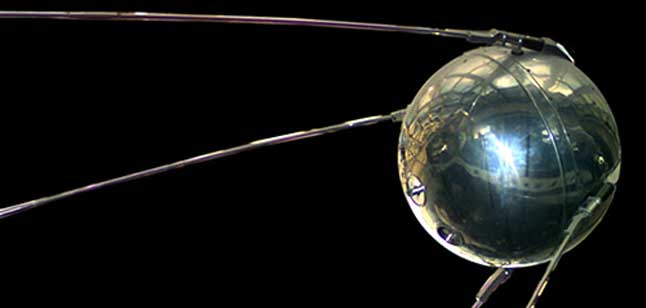Sputnik
Contact
Russian StudiesHumanities Building, Room 209 651-696-6374
651-696-6428 (fax)
davism@macalester.edu
facebook instagram blogspot

On October 4, 1957, the Soviet Union made history by sending the first artificial satellite into outer space. At the height of the Cold War, this move caused heightened tensions throughout the United States and the world as the majority of people were largely uninformed as to its capabilities. Physically, Sputnik 1, which roughly translates to “fellow traveler” from Russian, was not overwhelming. Made of mostly metal, it was a mere 23 inches in diameter and weighed only 183 pounds. For aerodynamic purposes, it had one R-7 booster in a spherical shape and attached to it were four straight metal rods. Its lead designers were Sergei Korolev and Kerim Kerimov. Since its flight in October of 1957, forty more, different Sputniks have been sent into orbit. Only Sputniks 40 and 41 were launched following the end of the Cold War, and their purpose was merely to commemorate the fortieth anniversary of the launch of Sputnik 1.
The launch of Sputnik 1 had a large impact on the Soviet Union and its people. It was a joyous occasion for supporters of the Soviet Union and an equally frightening one for those in the United States. The successful launch of Sputnik 1 was a major victory for the Soviet Union, for they had become the first nation to send an object into orbit. Sputnik 1, however, had very limited capabilities. Although it was extremely fast, with an orbit time of only 96 minutes, all it did was emit a high pitched beep. This allowed people to track its whereabouts for research and space exploration purposes. It could not take pictures or do anything more sophisticated. In retrospect, the anxiety about Sputnik’s launch seems to be much ado about nothing; however its symbolic meaning and historical implications were immense.
While Sputnik 1 marks a relatively peaceful, yet major development in the “space race” between the United States and the Soviet Union, the successful production of Soviet ICBM’s (Inter Continental Ballistic Missiles) does not. As the Soviet Union became the first nation to venture beyond the Earth’s atmosphere with Sputnik 1, they also proved their destructive capabilities by producing ICBMs before the United States in August 1957. Many parallels can be drawn between these two similar objects and the reactions that they evoked, the most blatant of which being that the launches of both projectiles represent aspects of the Cold War in which the Soviet Union bested the United States.
The Soviets successfully tested their first ICBM late in 1957, almost a full two years before the United States would in 1959. This major accomplishment is akin to that of the launch of Sputnik. The capabilities of the ICBM gave the Soviet Union a clear upper hand in the Cold War. This Soviet missile could reach a target nearly 4,000 miles away, meaning that the Soviets could hit the eastern seaboard of the United States. Furthermore, both objects proved the technological superiority of the Soviet Union at the time. However, equally so, both objects also created immense anxiety in both nations for they showed that nuclear warfare could be a reality looming on the horizon.
Following its successful launch, Sputnik’s influence quickly became visible in pop culture in the United States and the Soviet Union. The uneasiness Sputnik 1’s launch caused in the United States is exemplified in Michigan Governor G. Mennen Williams’ poem Sputnik. His poem, which was little more than a witty, short anecdote, appeared in the New York Times and served mostly to criticize President Eisenhower. He begins his poem addressing Sputnik, “You tell the world it’s a Commie sky, and Uncle Sam’s asleep.” This passage is insightful into the possible emotions that the Soviet Union elicited, as it refers to the skies as “Commie.” Having one nation, or ideal, own the sky would be a victory of catastrophic proportions in this era. Williams continues on to criticize the inactivity of Eisenhower. Many Americans viewed him as a do-nothing President, since he was seen golfing while the Soviets were scoring tremendous technological successes. Williams writes, “You say on fairway and on rough/ the Kremlin knows it all/ We hope our golfer knows enough/ To get us on the ball.” The ending of this clever poem, urging Eisenhower to “get us on the ball,” is also a reference to Sputnik’s spherical contour.
The launch of Sputnik 1 was not only consequential because it was the first object in outer space, but it also initiated a major portion of the space race within the Cold War, including the production of ICBMs, which created a new aura of hostility between the two powerful nations. The success of Sputnik 1 represented the superiority of the Soviet Union technologically, and this sentiment would stand until the United States first put a man on the moon in July 1969. Sputnik was certainly a monumental object in Russian history, and in the Cold War, and its presence and influence will surely not soon be forgotten.
“Sputnik”
Oh little Sputnik, flying high
With made-in-Moscow beep,
You tell the world it’s a Commie sky
and Uncle Sam’s asleep.
You say on fairway and on rough
The Kremlin knows it all,
We hope our golfer knows enough
To get us on the ball.
G. Mennen Williams
Governor of Michigan (1949-1961)
– Matt Caminiti, December 2009
Sources
- “Soviet Military Power.” https://www.fas.org/irp/dia/product/smp_86_ch2.htm
- “Sputnik and the Origin of the Space Age.” https://history.nasa.gov/sputnik/sputorig.html
- Garner, Joseph. We Interrupt This Broadcast: Events That Stopped Our Lives. Naperville, Ill. 2002
- “The Launch of Sputnik.” https://nhs.needham.k12.ma.us/ur/baker_00/03-04/Baker-LM-MB-3-04/the_launch_of_sputnik.htm